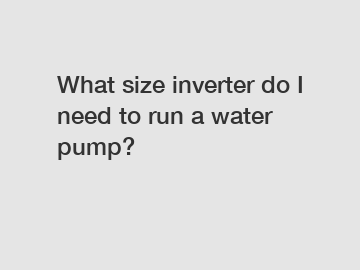What size inverter do I need to run a water pump?
What size inverter do I need to run a water pump?
To operate a water pump using an inverter, you will need to consider a few important factors in determining the appropriate size. The size of the inverter needed is influenced by the power requirements of the water pump, which can be determined by checking its wattage rating or amperage draw. Additionally, the starting current, known as the surge or peak current, must be taken into account.
To calculate the power requirements of the water pump, you need to know its wattage rating or amperage draw. The wattage rating is usually stated on the pump itself or in its documentation. If only the amperage draw is available, you can multiply it by the voltage (typically 120V or 240V) to obtain the power consumption in watts.

Once you have determined the power consumption, consider the surge or peak current needed to start the pump. Water pumps often require a higher initial current to overcome the resistance at startup. This surge current can be several times the normal operating current. Be sure to account for this to avoid undersizing the inverter, which may result in the pump failing to start or tripping the inverter's overload protection.
After calculating the power requirements and surge current, you can choose the appropriate size inverter. It is recommended to select an inverter with a continuous power rating slightly higher than the calculated power consumption to provide a buffer for efficiency and potential future upgrades. As for the surge current, some inverters are designed to handle brief surges while others provide continuous surge capability.
Choosing the right size inverter is crucial to ensure reliable pump operation and prevent damage. Undersizing the inverter could lead to insufficient power supply, causing the pump to run slower or not start at all. On the other hand, oversizing the inverter may result in unnecessary expense and reduced efficiency. By accurately determining the power requirements and surge current of the water pump, you can select an appropriately sized inverter that meets your needs while avoiding any potential complications.
In conclusion, determining the size of the inverter needed to run a water pump involves calculating its power consumption and accounting for the surge current. By understanding the power requirements and surge characteristics of the pump, you can choose the right size inverter, ensuring efficient and reliable operation. Whether for residential or industrial use, correctly sizing the inverter is essential for maintaining the functionality and longevity of the water pump.
Contact us to discuss your requirements of single phase string inverter for sale, Easy to install single phase string inverter, School hybrid storage inverter. Our experienced sales team can help you identify the options that best suit your needs.
325
0
0


Comments
All Comments (0)